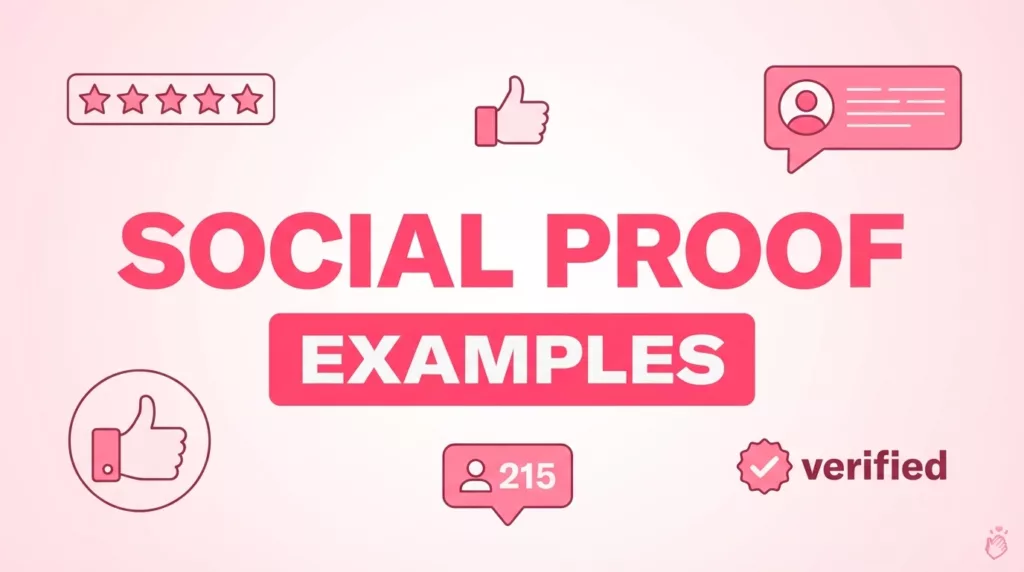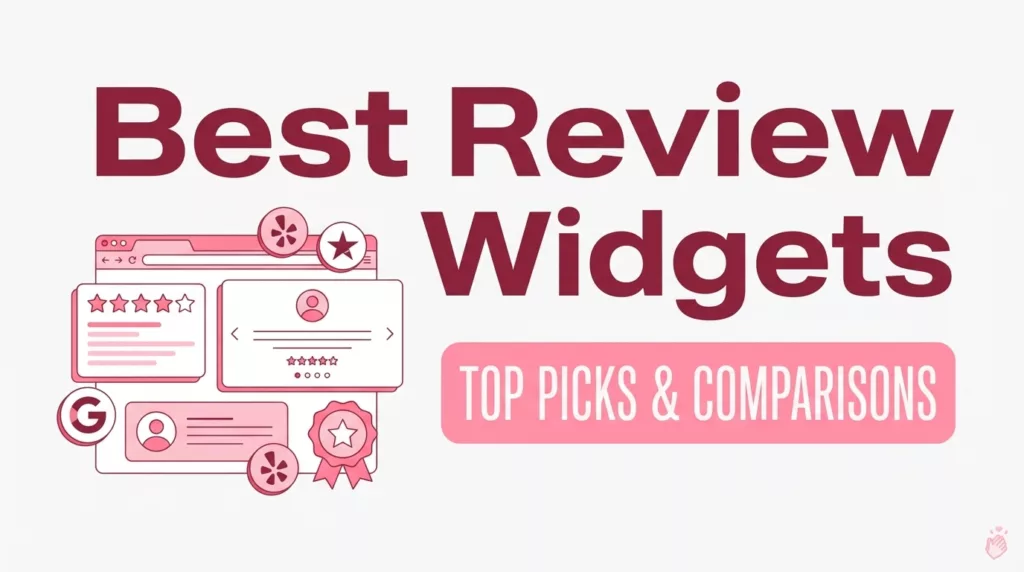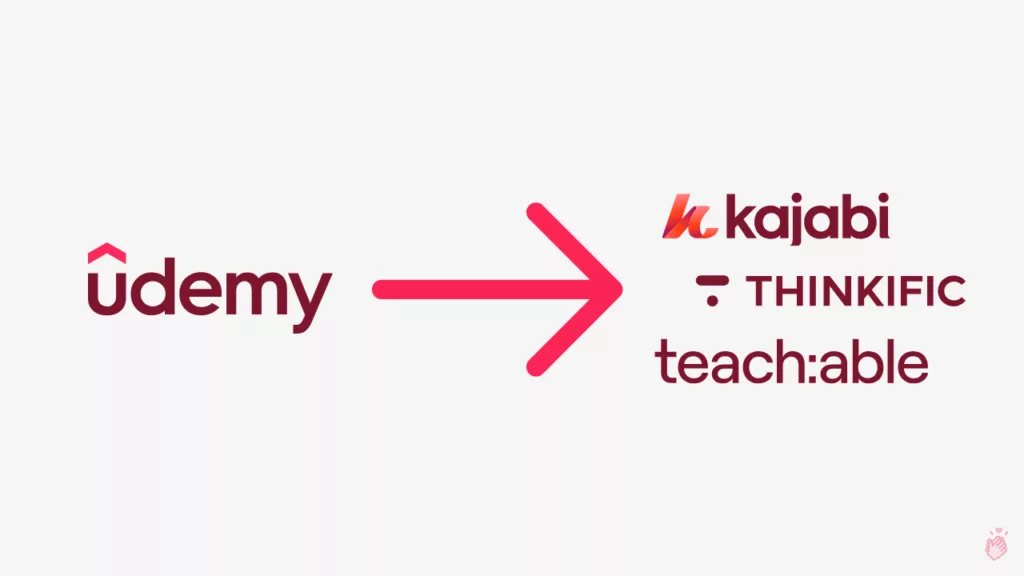98% of consumers read online reviews before making a purchase decision.
Let that sink in for a moment.

That means virtually EVERY potential customer who finds your business online or on Google Maps will judge you based on your Google reviews before they ever walk through your door or pick up the phone.
Yet here’s what’s shocking: Most businesses are completely winging their Google review management strategy. They’re leaving one of their most powerful marketing assets to chance.
After analyzing hundreds of businesses and testing dozens of Google review management tools, I’ve discovered that companies that invest in managing Google reviews (whether with Google review management software or not) see an average 25% increase in revenue within 6 months. That is why it is so important to focus on your Google Business Profile.
In this guide, I’ll show you exactly how to build a Google reviews management system that turns your Google Business Profile (formerly Google My Business) into a customer acquisition machine.
Here’s what you’ll learn:
- Why Google reviews are 10x more important than you think (hint: it’s not just about trust)
- The 6-step system that gets you 300% more positive reviews
- 15 Google review management tools compared (with real pros/cons)
- How to automate 80% of your review management
- Advanced strategies used by companies generating millions in revenue from online reviews
Let’s dive in.
Why Google Reviews Are Your Secret Weapon (The Data Will Shock You)
Google reviews aren’t just nice-to-have social proof anymore. They’re a fundamental ranking factor that directly impacts your bottom line and visibility in search result.
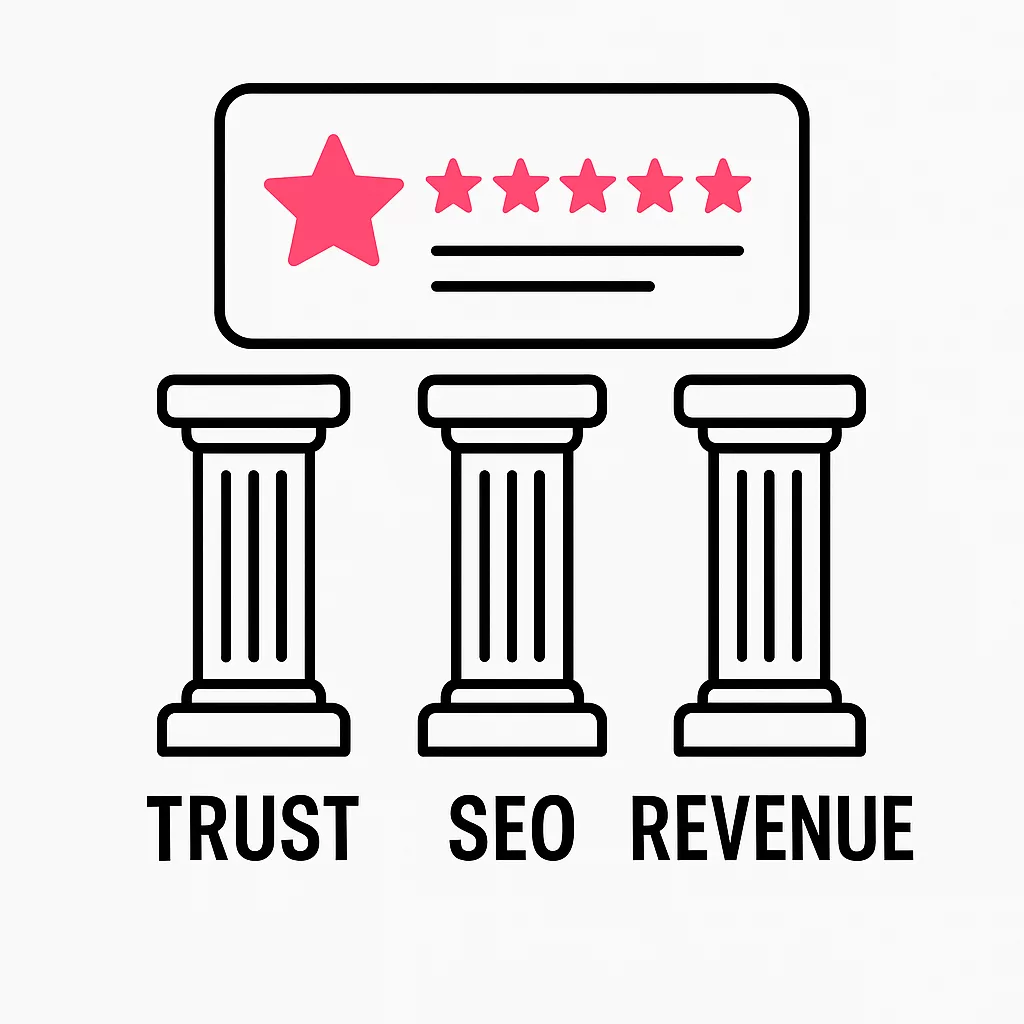
Here’s the proof:
The Trust Factor
- 63.6% of consumers specifically read Google reviews to assess business credibility
- Businesses with 4+ star ratings get 3x more clicks than those with lower ratings
- 88% of consumers trust a business more when it responds to ALL reviews (vs. 47% when businesses respond to none)
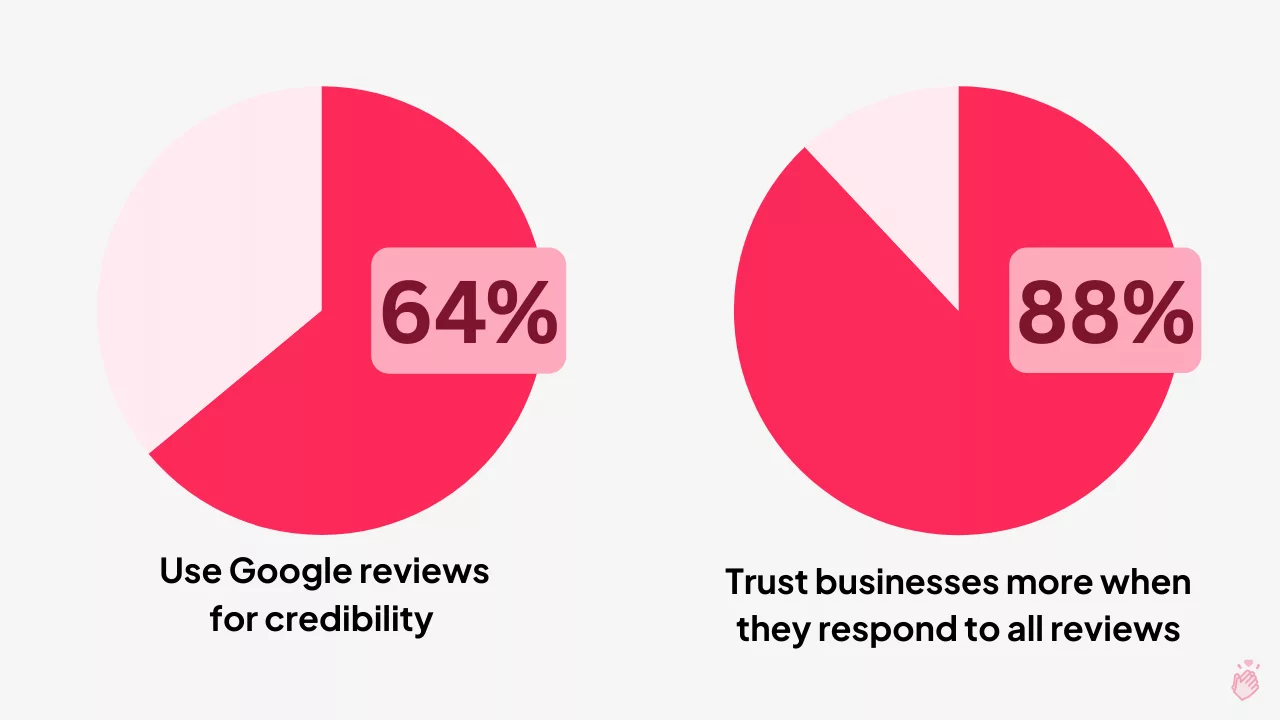
The SEO Goldmine
Google reviews are a direct ranking signal for local SEO. Here’s why:
- Fresh Content: Every new review adds fresh, keyword-rich content to your profile.
- Engagement Signals: A consistent review response strategy shows Google your business is active.
- Local Authority: High review volume signals business popularity to Google’s algorithm, boosting you in Google search.
Real Example: A local plumbing company increased their review count from 12 to 150+ in 6 months. Result? Their local search rankings jumped from page 3 to position #2 in the search results, generating an additional $40,000 in monthly revenue.
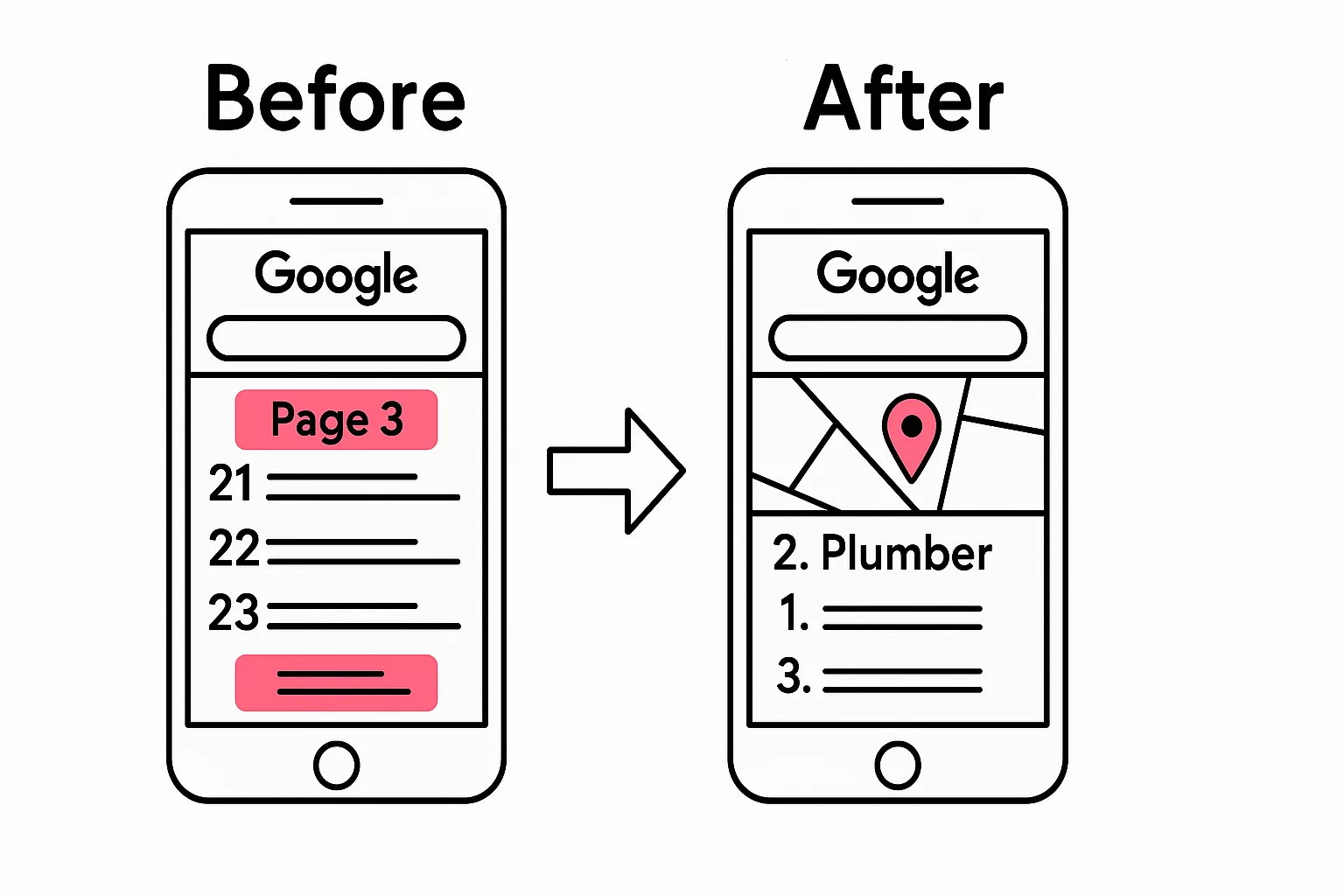
The Revenue Multiplier
- Businesses with 50+ reviews see 35% more revenue than those with fewer reviews.
- One additional star in your average rating can increase revenue by 5-15%.
- Responding to negative reviews can recover 25% of lost customers.
Bottom line: Your Google reviews are working 24/7 to either attract or repel customers. The question is: are they working FOR you or AGAINST you?
The 6-Step Google Review Management System That Actually Works
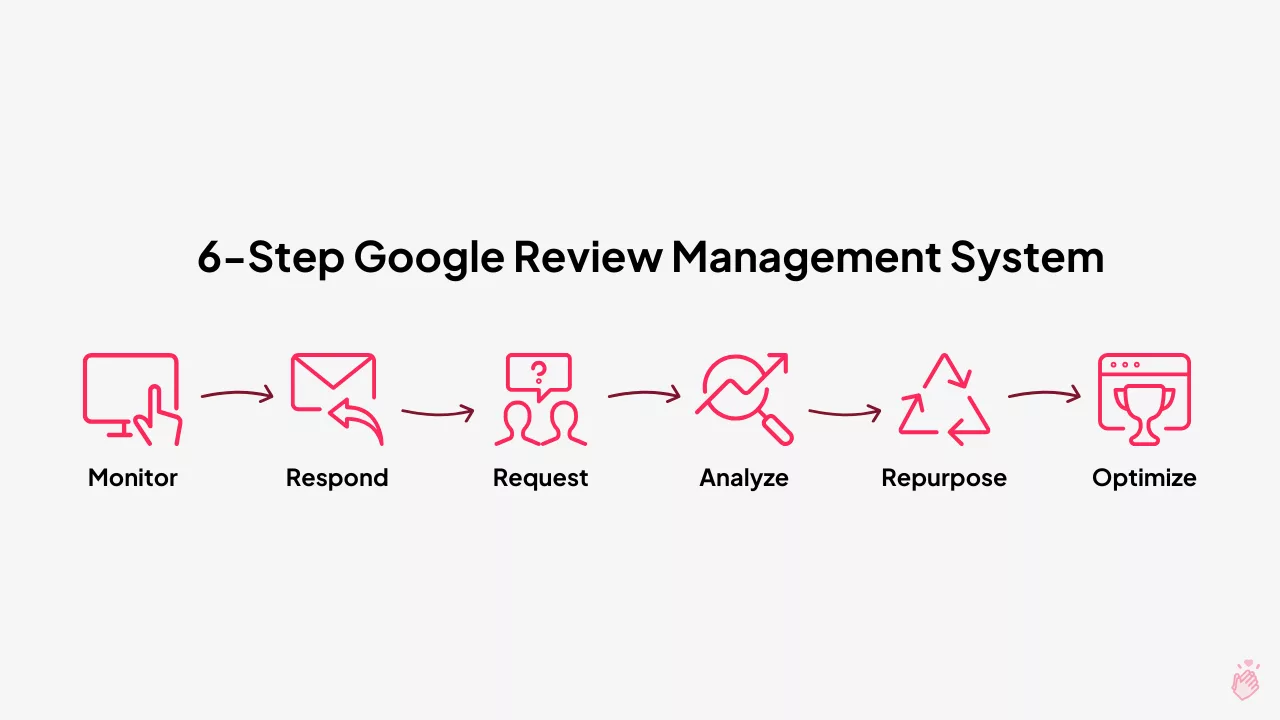
Most businesses approach review management backwards. They wait for reviews to come in, then scramble to respond.
Here’s the systematic approach that actually moves the needle and helps you manage Google presence effectively:
Step 1: Set Up Your Review Monitoring Foundation (15 minutes)
Enable notifications in your Google Business Profile dashboard:
- Log into your Google Business Profile
- Go to Settings → Notifications
- Turn on email notifications for new reviews
- Set up SMS alerts (if available in your area)
Pro tip: Don’t rely on Google’s notifications alone. They’re often delayed. Use a dedicated review management tool to monitor customer feedback in real-time (more on this below)..
Step 2: Create Your Response Framework (30 minutes)
Build templates for common scenarios to streamline review management, but make them feel personal:
5-Star Review Template:
Hi [Name],
Thank you so much for the amazing customer review! We’re thrilled to hear that [specific detail from their review].
[Personal touch about their experience]
We truly appreciate customers like you and look forward to serving you again soon!
Best regards,
[Your name]
[Business name]
1-Star Review Template:
Hi [Name],
I sincerely apologize for the experience you had with us. This is absolutely not the standard we strive for.
I’d love the opportunity to make this right. Please reach out to me directly at [email/phone] so we can discuss how to resolve this.
Thank you for bringing this feedback to our attention.
[Your name]
[Business name]
Step 3: Implement the “Golden Hour” Rule
Respond to ALL reviews within 24 hours (ideally within 1 hour for negative reviews).
Here’s why this matters for reputation management:
- 67% of customers expect a response within 24 hours.
- Fast responses show prospects that you’re actively engaged with customers.
- Google’s algorithm favors businesses that engage with their reviews.
Step 4: Launch Your Review Generation Campaign
This is where most businesses fail. They wait for reviews instead of systematically generating them.
The 3-Touch Review Request System:
Touch 1 – Immediate (Point of Sale): “If you’re happy with your experience today, would you mind leaving us a quick Google business review? Here’s the link: [short URL]”
Touch 2 – 24-48 Hours Later (Email): Send a follow-up email with a direct link to your Google review page.
Touch 3 – 1 Week Later (SMS): “Hi [Name], hope you’re enjoying your [product/service]! If you have 30 seconds, we’d love a quick Google review: [link]”
Pro tip: Only ask for reviews from customers who indicate customer satisfaction. Use a 2-step process: first ask “How was your experience?” If positive feedback, then request the review.
Step 5: Analyze and Optimize Monthly
Track these key metrics:
- Review velocity (reviews per month)
- Average rating trend
- Response rate (% of reviews you respond to)
- Conversion rate (% of customers who leave reviews when asked)
Step 6: Turn Reviews into Marketing Assets
Don’t let great reviews sit idle. Use them to boost customer experience perception::
- Feature them on your website (use a widget to embed Google reviews)
- Share them on social media
- Include them in email signatures
- Use them in sales presentations
What are the Best Google Review Management Tools?
After testing every major Google review management platform, here are the tools that actually deliver results:
Tier 1: Enterprise-Grade Powerhouses
1. Birdeye – The All-in-One Champion
Best for: Multi-location businesses wanting comprehensive reputation management
Key Features:
- Monitors 150+ review sites (including Google)
- AI-powered response suggestions
- Automated review request campaigns
- Sentiment analysis and competitor benchmarking
Pricing: $299+/month
Pros:
✅ Most comprehensive feature set
✅ Excellent multi-location management
✅ Strong automation capabilities
✅ Great customer support
Cons:
❌ Expensive for small businesses
❌ Steep learning curve
❌ Overkill if you only need basic review management
2. Podium – The SMS Review King
Best for: Local businesses wanting to leverage text messaging
Key Features:
- SMS-based review requests (highest conversion rate)
- Unified inbox for all customer messages
- Payment processing integration
- AI response suggestions
Pricing: $289+/month
Pros:
✅ Industry-leading SMS conversion rates
✅ Intuitive interface
✅ Great for customer communication beyond reviews
✅ Mobile-first design
Cons:
❌ Limited analytics compared to competitors
❌ Expensive for review-only needs
❌ Less comprehensive than Birdeye
Tier 2: Mid-Market Solutions
3. ReviewTrackers – The Analytics Beast
Best for: Data-driven businesses wanting deep insights
Key Features:
- Advanced sentiment analysis
- Competitor benchmarking
- Custom reporting dashboards
- Team collaboration tools
Pricing: $99+/month
Pros:
✅ Best-in-class review analytics
✅ Excellent reporting capabilities
✅ Great for tracking trends
✅ Competitive intelligence features
Cons:
❌ Interface can be overwhelming
❌ Limited automation features
❌ Focuses more on monitoring than generation
4. Grade.us – The White-Label Specialist
Best for: Agencies and businesses wanting branded solutions
Key Features:
- White-label dashboard options
- Smart review funneling (happy customers to Google, unhappy to private feedback)
- Multi-channel review requests
- Agency-focused features
Pricing: $99+/month
Pros:
✅ Innovative review funneling system
✅ Great for agencies
✅ Customizable branding
✅ Prevents some negative reviews from going public
Cons:
❌ Interface feels dated
❌ Limited integrations
❌ Smaller feature set than top-tier tools
5. SOCi – The Franchise Favorite
Best for: Multi-location franchises and enterprise chains
Key Features:
- Role-based permissions (corporate vs. local)
- Bulk response capabilities
- Brand compliance monitoring
- Advanced workflow management
Pricing: $200+/month
Pros:
✅ Excellent for franchise management
✅ Strong compliance features
✅ Scalable for large organizations
✅ Good workflow automation
Cons:
❌ Overkill for single-location businesses
❌ Complex setup process
❌ Expensive for small teams
Tier 3: Small Business Solutions
6. BrightLocal – The SEO Toolkit
Best for: Small businesses managing local SEO holistically
Key Features:
- Basic review monitoring
- Local search rank tracking
- Citation management
- Google Business Profile auditing
Pricing: $29+/month
Pros:
✅ Very affordable
✅ Comprehensive local SEO features
✅ Simple to use
✅ Good for DIY marketers
Cons:
❌ Limited review management features
❌ No advanced automation
❌ Basic reporting compared to dedicated tools
7. ResponseScribe – The AI Assistant
Best for: Small businesses wanting AI-powered simplicity
Key Features:
- AI-generated response suggestions
- Multi-platform monitoring
- Simple review request tools
- Mobile-friendly interface
Pricing: $79+/month
Pros:
✅ Easy to use
✅ AI saves time on responses
✅ Modern interface
✅ Good value for money
Cons:
❌ Limited advanced features
❌ Newer platform (less proven)
❌ Smaller integration ecosystem
Free/Built-in Options
8. Google Business Profile (Free)
Best for: Businesses just starting with review management
Key Features:
- Basic review monitoring
- Email notifications
- Direct response capability
- Integration with Google ecosystem
Pricing: Free
Pros:
✅ Completely free
✅ Direct from Google
✅ No learning curve
✅ Sufficient for very small businesses
Cons:
❌ Very limited features
❌ No automation
❌ No analytics or insights
❌ Can’t manage multiple locations efficiently
Advanced Review Management Strategies (The Tactics That Separate Winners from Losers)
Strategy 1: The Review Velocity Accelerator
Most businesses get 1-3 reviews per month. Top performers get 50+. Here’s how to manage google reviews for velocity:
The 10-Touch Review Generation Sequence:
- Point of sale: Verbal ask + business card with QR code
- Day 1: Thank you email with subtle review mention
- Day 3: Direct review request email
- Day 7: Follow-up email (if no review)
- Day 14: SMS review request
- Day 21: Phone call follow-up (for high-value customers)
- Day 30: Final email with incentive mention (not for review, but for feedback)
- Month 3: “How are you doing?” check-in with soft review ask
- Month 6: Holiday/seasonal message with review mention
- Month 12: Anniversary message with review request
Result: 35-50% of satisfied customers will leave a review (vs. 2-5% with no system).
Strategy 2: The Negative Review Recovery Protocol
When you get a negative Google review, most businesses panic. Smart businesses see opportunity.
The 4-Step Recovery Process:
Step 1: Immediate Response (Within 1 Hour)
Hi [Name],
Thank you for bringing this to our attention. I sincerely apologize for the experience you described – this is not the standard we strive for.
I’d like to make this right immediately. Please call me directly at [phone] or email [email] so we can resolve this properly.
[Name]
[Title]
Step 2: Private Resolution (24-48 Hours)
- Call the customer personally
- Listen completely before responding
- Offer specific solution + something extra
- Follow up to ensure satisfaction
Step 3: Public Follow-Up
Hi [Name],
Thank you for giving us the opportunity to make this right. I’m glad we were able to resolve your concerns and that you’re happy with the solution.
We truly appreciate your patience and customer feedback – it helps us serve all our customers better.
Best regards,
[Name]
Step 4: Review Update Request (1 Week Later)
Hi [Name],
I hope the solution we provided has resolved your concerns completely. If you feel we’ve made things right, would you consider updating your Google review to reflect your final experience with us?
[Name]
Best regards,
Success rate: 60-70% of customers will update their review to positive after this process.
Strategy 3: The Competitor Review Intelligence System
Track your top 3 competitors’ reviews monthly:
- What are customers complaining about?
- What do they love?
- What service gaps can you fill?
Example: A restaurant noticed competitors getting complaints about wait times. They implemented a “15-minute guarantee” and prominently mentioned it in their review responses. Result: 23% increase in positive reviews mentioning fast service.
Strategy 4: The Review Content Optimization Method
Turn your reviews into SEO gold to help you manage google rankings:
- Respond with target keywords: If someone mentions “best pizza,” respond with “Thank you for calling us the best pizza in [city]!”
- Ask specific questions: Instead of “please leave a review,” say “If you loved our customer service, would you mind mentioning that in a Google review?”
- Guide review content: “We’d love to hear about your experience with our [specific service] in a review!”
Review Management Automation That Actually Works
The 80/20 Automation Rule
Automate the routine stuff, personalize the important interactions.
What to Automate (80%):
- Review monitoring and alerts
- Initial review request sequences
- Response templates for common scenarios
- Monthly reporting (exporting data to Google Sheets)
- Positive review sharing on social media
What to Keep Manual (20%):
- Responses to negative reviews
- High-value customer interactions
- Complex complaint resolution
- Personalized follow-ups
The Ultimate Automation Stack
For Small Businesses ($200/month total):
- Primary tool: ResponseScribe ($79/month)
- Email automation: Mailchimp ($99/month)
- SMS: SimpleTexting ($25/month)
For Medium Businesses ($500/month total):
- Primary tool: ReviewTrackers ($199/month)
- CRM integration: HubSpot ($200/month)
- Advanced SMS: Podium add-on ($100/month)
For Enterprise ($1000+/month):
- Primary tool: Birdeye ($500/month)
- Advanced CRM: Salesforce integration ($300/month)
- Additional platforms: SOCi for multi-location ($200/month)
Automation Workflow Example
Trigger: Customer makes purchase
Action 1: Add to “review request” email sequence
Action 2: Send thank you email (Day 1)
Action 3: Send review request email (Day 3)
Action 4: If no review, send SMS (Day 7)
Action 5: If negative feedback, alert manager immediately
Action 6: If positive review received, auto-share on social media
Measuring What Matters (The KPIs That Predict Success)
Primary Metrics
- Review Velocity: Reviews per month (target: 20+ for local businesses)
- Average Rating: Overall star rating (target: 4.3+)
- Response Rate: % of reviews responded to (target: 100%)
- Response Time: Average time to respond (target: <4 hours)
Secondary Metrics
- Request Conversion Rate: % of customers who leave reviews when asked (target: 15%+)
- Negative Review Recovery Rate: % of negative reviews resolved positively (target: 50%+)
- Review-to-Revenue Ratio: Revenue attributed to review-driven customers
Advanced Analytics
- Sentiment Trend Analysis: Track positive/negative customer sentiment over time
- Keyword Analysis: What words appear most in your reviews?
- Competitor Gap Analysis: Where do you outperform/underperform vs. competitors?
Monthly Review Report Template
GOOGLE REVIEW PERFORMANCE – [MONTH]
HEADLINE METRICS:
• New Reviews: XX (+/- XX from last month)
• Average Rating: X.X stars (+/- X.X from last month)
• Total Reviews: XXX
• Response Rate: XX%
KEY HIGHLIGHTS:
• Most mentioned positive: [keyword/theme]
• Most mentioned negative: [keyword/theme]
• Best performing review request method: [email/SMS/in-person]
ACTION ITEMS FOR NEXT MONTH:
• [Specific improvement based on data]
• [Process adjustment needed]
• [New strategy to test]
Handling the Dark Side (Fake Reviews, Crisis Management, and Google Policy)
Dealing with Fake Reviews
Identification Signs:
- Generic language (“great service,” “highly recommended”)
- Posted from accounts with no profile picture or review history
- Multiple reviews from same IP address (if you have analytics)
- Reviews mentioning services you don’t offer
Removal Process:
- Flag the inappropriate review in your Google Business Profile.
- Report through Google’s support channels
- Document everything (screenshots, evidence)
- Follow up persistently (Google’s first response is often “no”)
Timeline: Legitimate fake reviews typically get removed within 2-4 weeks with persistent follow-up.
Crisis Management Protocol
When you receive multiple negative reviews quickly:
Hour 1: Assess the situation
- Is this a legitimate service failure?
- Coordinated attack?
- Competitor sabotage?
Hour 2-24: Immediate response
- Respond professionally to each review
- Address the core issue publicly
- Contact customers privately for resolution
Day 2-7: Damage control
- Accelerate positive review generation
- Increase customer service quality temporarily
- Monitor for additional negative reviews
Week 2+: Recovery and prevention
- Implement process improvements
- Share positive resolution stories
- Rebuild review momentum
Google Policy Compliance
What Google Prohibits:
- Incentivizing reviews with payments/discounts
- Writing fake reviews
- Asking friends/family to write reviews
- Posting reviews from business computers/networks
What Google Allows:
- Asking satisfied customers for reviews
- Providing direct links to review pages
- Following up with customers via email/text
- Offering general discounts unrelated to reviews
Best Practice: Focus on earning reviews through excellent service, not gaming the system.
Industry-Specific Review Strategies
Restaurants and Food Service
Special Considerations:
- Reviews heavily focus on food quality, service speed, atmosphere
- Photos in reviews are crucial
- Negative reviews about food safety can be devastating
Winning Strategies:
- Encourage photo reviews with great plating
- Respond to negative food reviews with specific improvement actions
- Highlight hygiene and safety measures in responses
Healthcare and Professional Services
Special Considerations:
- Privacy concerns (HIPAA compliance)
- Trust and credibility are paramount
- Longer decision-making cycles
Winning Strategies:
- Focus on staff friendliness and facility cleanliness
- Highlight credentials and experience in responses
- Never discuss specific medical details in public responses
Home Services and Contractors
Special Considerations:
- High-ticket purchases with long consideration periods
- Project-based work creates natural review opportunities
- Before/after photos are powerful
Winning Strategies:
- Request reviews at project completion
- Encourage before/after photo reviews
- Highlight licensing, insurance, and warranties
Retail and E-commerce
Special Considerations:
- Product quality vs. service quality reviews
- Shipping and return policy feedback
- Price sensitivity mentions
Winning Strategies:
- Segment review requests by product category
- Address shipping/return concerns proactively
- Use reviews to improve product offerings
The Future of Review Management (What’s Coming in 2025+)
AI and Machine Learning Integration
Current State: Basic sentiment analysis and response suggestions Coming Soon:
- Predictive review scoring (identify customers likely to leave negative reviews)
- Automated crisis detection and escalation
- AI-generated personalized responses that sound human
Visual Review Management
Current State: Text-based reviews dominate Coming Soon:
- Video review integration
- AR/VR experience reviews
- Enhanced photo review management tool features
Cross-Platform Unification
Current State: Separate management for Google, Facebook, Yelp, etc. Coming Soon:
- Universal review management dashboards
- Cross-platform review syndication
- Unified customer feedback profiles
Advanced Analytics and Prediction
Current State: Basic reporting and trend analysis Coming Soon:
- Revenue attribution modeling
- Customer lifetime value correlation
- Predictive reputation management scoring
Your 30-Day Quick-Start Action Plan
Week 1: Foundation Setup
Day 1-2: Audit current review situation
- How many Google reviews do you have?
- What’s your average rating?
- How many recent reviews are unanswered?
Day 3-4: Choose and set up tools
- Implement basic monitoring (even if just Google notifications)
- Choose a Google review management software from our list above
- Set up basic response templates
Day 5-7: Create your review request process
- Design email templates for review requests
- Create business cards or flyers with review QR codes
- Train staff on verbal review requests
Week 2: System Implementation
Day 8-10: Launch monitoring and response system
- Respond to all existing unanswered reviews
- Set up daily monitoring routine
- Begin using templates for new reviews
Day 11-14: Start review generation
- Begin asking every satisfied customer for reviews
- Send follow-up emails to recent customers
- Implement point-of-sale review requests
Week 3: Optimization and Automation
Day 15-18: Analyze initial results
- Track response rates to different request methods
- Measure time-to-response for reviews
- Identify most common review themes
Day 19-21: Refine and automate
- Optimize templates based on results
- Set up automated email sequences
- Improve staff training on review requests
Week 4: Scale and Systematize
Day 22-25: Advanced implementation
- Set up negative review recovery protocols
- Create monthly reporting system
- Implement competitor monitoring
Day 26-30: Future planning
- Set 90-day review goals
- Plan staff incentives for review generation
- Schedule monthly review strategy sessions
The Bottom Line: Your Reviews Are Your Revenue
Here’s what I want you to remember:
Your Google reviews aren’t just feedback – they’re a 24/7 sales team.
Every review is working to either attract or repel potential customers. Every response is showing prospects how you handle customer relationships. Every star rating is influencing whether someone chooses you or your competitor and where you appear in search results.
The businesses that treat Google review management as a core business function – not an afterthought – are the ones dominating their markets.
The companies getting the best results follow this simple formula:
Systematic Review Generation + Professional Response Management + Continuous Optimization = Revenue Growth
Don’t over-complicate it. Pick one tool from our list above, perhaps trying a comprehensive google review management services provider if you need hands-off help. Implement the 6-step system. Stick to it for 90 days.
Your future customers are reading your reviews right now. What story are you telling them?
Ready to transform your online reputation into a revenue machine?
Start with Week 1 of the action plan above. In 30 days, you’ll have a review management system that works automatically to grow your business.
And remember: every day you wait is another day your competitors might be building a stronger online reputation than yours.
The best time to start managing Google reviews was a year ago. The second best time is right now.
Turn Google stars into real sales, without enterprise bloat.
Create your free Shapo account, connect your Google Business Profile in one click, and launch a Review Booster link today. In 30 days you’ll have:
- More reviews
- Rich-snippet star
- On-site proof
→ Start with Shapo (free) and watch new customers follow the stars to your door.

